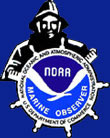 We talked about the Jason Project and what it offers school systems. Now here is an example from a school in Smithfield Rhode Island.
We talked about the Jason Project and what it offers school systems. Now here is an example from a school in Smithfield Rhode Island.From the Providence Journal:
(Pix Left - Dr. Robert Ballard, live on the screen from the Mystic Aquarium, at upper right, speaks to teachers from around the state during a conference yesterday at Smithfield High School. Technical coordinator Michael Deslauriers is in the foreground.)
A group of science teachers and administrators from 10 public school districts in northern Rhode Island received a glimpse into the future of science education in Rhode Island and, perhaps, the nation yesterday.
Robert Ballard, discoverer of the Titanic and Bismarck wrecks, teleconferenced with the group, seated in the Smithfield High School library, from his office at the Institute for Marine Exploration at Mystic Aquarium, in Connecticut.
University of Rhode Island scientists under his supervision are excavating a sunken ship from the Byzantine era (about 1,500 years old) at the bottom of the Black Sea, near the Turkish shoreline, he explained.
Another television screen showed a live action feed from the Alliance, a NATO research vessel where the team is based.
“We’ll be getting into the stern of the ship in a day or so, where we hope we’ll see a greater diversity of artifacts, possibly even bodies,” Ballard told the rapt audience. Any human remains found in the oxygen-less waters at the bottom of the Black Sea are “likely to be perfectly preserved,” he said.
Smithfield High is the first high school in the world to be connected to the Inner Space Center at the University of Rhode Island, a place where university researchers monitor, track and share information about oceanography and archaeology in real time.
Half a year ago, Ballard, who created Inner Space, partnered with the Smithfield School Department to develop a control center that would enable students to interact directly with scientists engaged in ocean exploration anywhere on the planet, much as university-level researchers do.
The goal is to bring the technology into every science classroom in every school in the state.
“As the Ocean State, we have the opportunity to develop a unique curriculum, where we teach what we normally teach, and put an ocean take on it,” said Ballard. “This is an opportunity to be the tip of the spear.”
Considering yesterday’s setting was a public high school library, and not, say, a command center for NASA, the setup was impressive.
Three black, plasma televisions arrayed on a wall. Two high resolution computer monitors cycling a series of graphs, charts, and tables on a table below them. Behind hummed a massive black crate concealing a handful of networked computers, the brains of the operation.
Bridget Buxton, the project archeologist and an assistant professor at URI, explained from the Alliance live feed that the ship had been damaged in rough seas recently, and so a submersible could not be sent underwater to give the audience a glimpse of the wreckage.
Ballard, seated before a console identical to the one in the library, took questions from teachers, much as Smithfield students did in March, when his team was studying the Flower Garden Banks National Marine Sanctuary in the Gulf of Mexico.
This coming school year, Smithfield students will talk with Ballard’s team as they monitor changes in wildlife in Monterey Bay, Calif., another nationally designated underwater sanctuary.
Lauren Woods, an oceanography teacher at Woonsocket High School, liked that the program would allow students to interact regularly with scientists over the course of a year. She said her district has been incorporating video conferences in their curriculum for many years, but those opportunities are too few.
“It’s hard for kids to come up with questions on demand. This way, they can develop a relationship with the scientists so that there wouldn’t be any barrier to asking questions,” she said.
But the hardware that makes the innovative program work isn’t cheap.
Smithfield Supt. Robert O’Brien said the department would not have been able to afford the equipment, which included access to Internet2, the high speed network used by universities, had it not been on loan from URI.
“Cost is going to be the biggest hurdle,” observed Edward Saravo, a biology teacher at Johnston High School.
O’Brien said a more efficient system is in the works that will make the system more lightweight and portable. The school is also testing a larger version of the system in its 840-seat auditorium, where the entire high school can gather, if and when Ballard’s team makes a major discovery.
“It will become very affordable as the technology develops,” O’Brien said. “We’re at the very beginning of the future.”
Weather StorySubstropical Storm Jerry

The National Hurricane Center announced Sunday morning that subtropical depression 11 had formed in the north central Atlantic. Before noon, the system had strengthened into a named storm. The NHC said the storm could acquire tropical characteristics later on Sunday.
Jerry poses no threat to the US mainland.
Maritime Notes
We talk about how severe weather like TS Jerry generates waves that effect ships at sea. Below is a video of ships listing and or taking large waves.
RS


































































































![Validate my RSS feed [Valid RSS]](valid-rss.png)